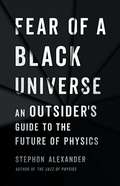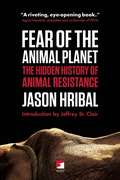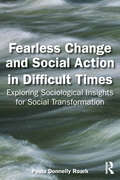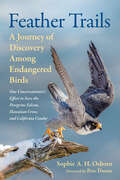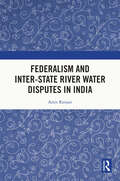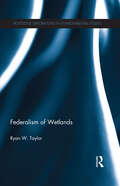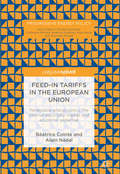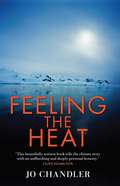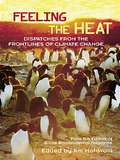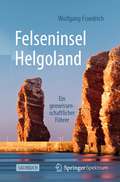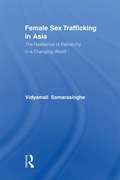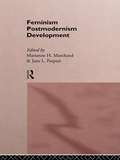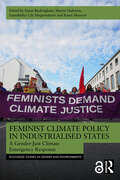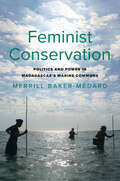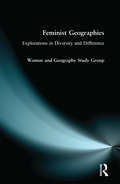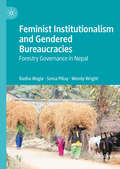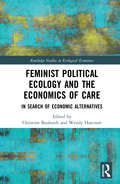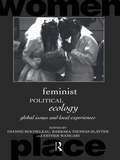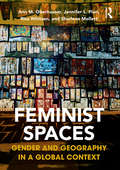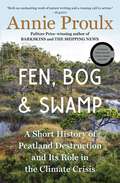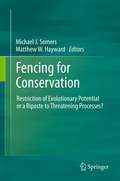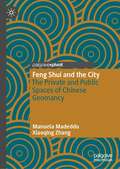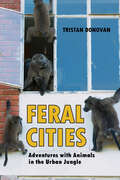- Table View
- List View
Fear of a Black Universe: An Outsider's Guide to the Future of Physics
by Stephon AlexanderIn this important guide to science and society, a cosmologist argues that physics must embrace the excluded, listen to the unheard, and be unafraid of being wrong. Years ago, cosmologist Stephon Alexander received life-changing advice: to discover real physics, he needed to stop memorizing and start taking risks. In Fear of a Black Universe, Alexander shows that great physics requires us to think outside the mainstream -- to improvise and rely on intuition. His approach leads him to three principles that shape all theories of the universe: the principle of invariance, the quantum principle, and the principle of emergence. Alexander uses them to explore some of physics' greatest mysteries, from what happened before the big bang to how the universe makes consciousness possible. Drawing on his experience as a Black physicist, he makes a powerful case for diversifying our scientific communities. Compelling and empowering, Fear of a Black Universe offers remarkable insight into the art of physics.
Fear of the Animal Planet
by Jason Hribal Jeffery St. ClairTaking the reader deep inside of the circus, the zoo, and similar operations, Fear of the Animal Planet provides a window into animal behavior: chimpanzees escape, elephants attack, orcas demand more food, and tigers refuse to perform. Indeed, these animals are rebelling with intent and purpose. They become true heroes and our understanding of them will never be the same.
Fearless Change and Social Action in Difficult Times: Exploring Sociological Insights for Social Transformation
by Paula Donnelly RoarkOur divided politics, unable to solve the challenges we face concerning society’s hierarchies of injustice, poverty, endless war, and climate change, are now backtracking to even more division. But the reality goes far deeper than the simple politics of left and right. For true change, we need something more profound: a culture shift, a collective change of consciousness.Fearless Change and Social Action in Difficult Times argues that culture shifts don’t just happen, they require a strong focus on social and cultural human connection which neither political nor economic power can provide alone. It is only deep participation and social integrative power which have the capacity to create these necessary cultural and societal transformations. Developing awareness in participatory groups of thought-worlds which remain out-of-sight but give cover to the implicit rules of culture and society is the first step to creating shared awareness of constructs and negative thought-worlds that subconsciously support inequality. Consciously putting aside those that are negative allows for the emergence of new positive realities and social movements. Thus, the real revolution is of the mind. It does take courage, but this is the process by which better futures are created.Offering significant contributions to sociology and social theory, this book promotes an understanding that societal change is rooted in social power and cultural shifts. Inclusive in its presentation, students, professors, NGO professionals, volunteers, activists, and interested observers will find this book of high interest.
Feather Trails: A Journey of Discovery Among Endangered Birds
by Sophie A. OsbornNamed ABA Birding Book Club&’s Best Book of the Year&“[This book] deserves to be read widely, because it is only in coming to understand these animals, suggests Osborn, that we can choose to love and help them.&”—New ScientistThe story of one woman&’s remarkable work with a trio of charismatic, endangered bird species—and her discoveries about the devastating threats that imperil them.In Feather Trails, wildlife biologist and birder Sophie A. H. Osborn reveals how the harmful environmental choices we&’ve made—including pesticide use, the introduction of invasive species, lead poisoning, and habitat destruction—have decimated Peregrine Falcons, Hawaiian Crows, and California Condors.In the Rocky Mountains, the cloud forests of Hawai&’i, and the Grand Canyon, Sophie and her colleagues work day-to-day to try to reintroduce these birds to the wild, even when it seems that the odds are steeply stacked against their survival.With humor and suspense, Feather Trails introduces us to the fascinating behaviors and unique personalities of Sophie&’s avian charges and shows that what endangers them ultimately threatens all life on our planet.More than a deeply researched environmental investigation, Feather Trails is also a personal journey and human story, in which Sophie overcomes her own obstacles—among them heat exhaustion, poachers, rattlesnakes, and chauvinism.Ultimately, Feather Trails is an inspiring, poignant narrative about endangered birds and how our choices can help to ensure a future not only for the rarest species, but for us too.&“An intimate look at the wonder and effort needed for working with endangered species in the wild. [Osborn&’s] matter-of-fact writing style and wry humor make the reader part of the action.&”—Booklist (starred review)
Federalism and Inter-State River Water Disputes in India
by Amit RanjanThis book examines the Union-State and inter-State relations concerning water issues in India. It analyses the federal structure in India and looks at its effectiveness in addressing the inter-state river water disputes in the country through three cases: the Cauvery, Krishna and Mahadayi Rivers water dispute. It probes into the physical, political, legal and constitutional measures taken by the Union government and the states to deal with the inter-State and Union-State tussles over inter-State river waters. The author studies the debate over centralisation and decentralisation of water resources, as well as the inter-state river water disputes that have aroused feelings of sub-nationalism in many regions of India. Finally, this book also examines socio-political tensions over multipurpose water projects and other supply-side infrastructures, and their efficacy in addressing India’s increasing water problems. This book will interest researchers and students of Environmental Politics, Political Science, Public Policy, Environmental Geography, Indian Politics, South Asian Studies, Environmental Economics, Environmental Policy, River Management, and Resource politics.
Federalism of Wetlands: Federalism Of Wetlands (Routledge Explorations in Environmental Studies)
by Ryan W. TaylorThis book investigates the consequences of redundant state and federal environmental regulations in the United States. Drawing on the most exhaustive statistical analysis of US federal wetland permits ever constructed, the book uncovers the disjointed world of wetland regulation. The author starts by examining the socioeconomic and environmental factors driving individuals to apply for environmental regulatory permits and the regional inconsistencies encountered in federal environmental regulatory program performance. The book goes on to demonstrate that states have more power in federal relationships than scholars often believe and that individual state policies are important even in a time of strong federal governance. Evidence shows that such intergovernmental redundancy serves to increase overall regulatory program effectiveness. This book breaks new ground in the subjects of federalism and environmental regulation by rejecting the traditional approach of picking winners and losers in favour of a nuanced demonstration of how redundancy and collaboration between different levels of governance can make for more effective governmental programs. The book is also innovative in its use of the perspectives of regulated citizens not as a point of judgment, but as a means of introducing a constructive new way of thinking about political and administrative boundaries within a federalist system of governance. The book provides relevant context to wider political debates about excessive and duplicative regulatory oversight and will be of interest to Environmental Policy students and administrators.
Feed-in tariffs in the European Union
by Alain Nadaï Béatrice CointeThis book is a sociological account of the historical trajectory of feed-in tariffs (FITs) as an instrument for the promotion of renewable energy in Europe. Chapters analyse the emergence and transformations of feed-in tariffs as part of the policy arsenal developed to encourage the creation of markets for RES-E in Europe. The authors explore evolving conceptions of renewable energy policy at the intersection between environmental objectives, technological change and the ambition to liberalise the internal electricity market. They draw conclusions on the relationships between markets and policy-making as it is instituted in the European Union, and on the interplay between the implementation of a European vision on energy and national politics. Distinctive in both its approach and its methods the books aim is not to discuss the design of feed-in tariffs and their evolution, nor is it to assess their efficiency or fairness. Instead, the authors seek to understand what makes feed-in tariffs what they are, and how this has changed over time.
Feel The Wind (Let's-Read-and-Find-Out Science)
by Arthur DorrosHave you ever felt the wind tickle your face or heard it whistle through your window? Did you know that some wind travels faster than a car? <p><p> Air is always moving. We can't see air moving, though we can watch it push clouds across the sky, or shake the leaves of a tree. We call moving air the wind. In this enlarged edition, find out about the wind - what causes it, how it can be used to help us, and how it affects the weather. <p> Arthur Dorros shows you how to make your own weather vane, and in simple terms, with playful illustrations, he explains just what makes the wind that blows all around us.
Feeling The Heat
by Jo ChandlerIn Feeling the Heat, journalist Jo Chandler sets out on a quest that takes her across the Antarctic ice, under the seas and through the tropical rainforests of far north Queensland. Her mission is to explore one of the defining mysteries of our age-climate change. The story Chandler tells is an epic adventure complete with heroes and villains. It's a love story for those with an affection for nature. A reality show like no other. It's also a story of science in its most glorious, pure form. Chandler takes us into wild landscapes in the company of scientists trying to decode climate information that will be critical to the decisions we make for the future of the planet. Written in the vein of Susan Orlean's The Orchid Thief, and by turn lyrical, funny, and achingly sad, Feeling the Heat reveals startling truths about that delicate, confounding organism we call Earth. Winner: 2012 Bragg UNSW Press Prize for Science Writing Shortlisted: 2011 Queensland Premier's Literary Awards Science Writer Award Longlisted: 2012 John Button Prize
Feeling the Heat: Dispatches from the Front Lines of Climate Change
by From the Editors of E/The Environmental MagazineFor an increasing number of people, global warming is not an academic and scientific debate, but a matter of survival. As the planet warms at a rate of four degrees Fahrenheit per century, violent storms are increasing in frequency, icebergs are melting, sea level is rising, species are losing their habitats, and temperature records are being broken. Feeling the Heat consists of chapter-length visits by well-known authors to actual world "hot" spots, where people are already coping day-to-day with the consequences of climactic disruption. The locations for the book were strategically chosen because each represents a separate and important global warming impact, such as rising tides, melting glaciers, evolving ecosystems and air pollution. Feeling the Heat takes global warming out of the realm of armchair speculation and arcane scientific debate, revealing the process of climate change to be ongoing, serious and immediate.
Feldspar Minerals: 2 Chemical and Textural Properties
by J.V. Smith33 14. 3. 5 REE between Plagioclase and Aqueous Fluid 0 Cullers et al. (1973) measured the distribution of REE at 850 C and 750 bars pressure between a natural plagioclase, An , and gaseous water. The rare earths 65 favored the plagioclase by a factor which varies from about 25 for Ce to 10 for Lu. Data were also obtained for forsterite, diopside, enstatite and two rhyolite glasses, on the one hand, and water on the other hand, thereby permitting estimation of the partition coefficients between all pairs of phases. 14. 4 Chemical Substitution in Natural Feldspars 14. 4. 1 Introduction It is quite impracticable to give all the data on chemical substitution in natural feldspars: indeed many of the details are significant only to some particular pegmatite or rock body. As far as possible, emphasis is placed on features of general interest to crystal chemists and to petrologists. Ironically the well established features can be described more easily than the uncertain ones, and unfortunately it is necessary to use valuable space on data of dubious value. The bibliography is fairly complete, but it was impracticable to locate all data, especially those in obscure journals. Each reference is followed by a list of the elements referred to in the paper, thereby permitting a reader to compile a fairly compre hensive set of references on any chosen element. Not all papers are mentioned in the text. The book on Geochemistry and Mineralogy of Rare Elements, etc.
Felseninsel Helgoland: Ein geowissenschaftlicher Führer
by Wolfgang FraedrichHelgoland hat unter den deutschen Nordseeinseln als Naturraum und auch als Kulturraum eine Sonderrolle. Dies verständlich der Leserschaft zu erläutern ist das vorrangige Ziel dieses Buches. Das Buch richtet sich an alle, die Interesse an der Natur, an der Entstehung von Landschaften, an geologischen Fragen und der Insel Helgoland schlechthin haben. Adressaten sind vornehmlich „interessierte Laien“, das Buch richtet sich aber auch an Studierende, Lehrkräfte sowie Schülerinnen und Schüler der Sekundarstufe II. Vier detailliert erläuterten Exkursionsvorschlägen sind die wichtigen theoretischen Grundlagen zum besseren Verständnis vorangestellt. Auf eine wissenschaftliche Ausdrucksweise wurde verzichtet, wo immer dies vertretbar war. So haben auch Laien eine Chance, geowissenschaftliches Denken in der Landschaft direkt nachzuvollziehen.
Female Sex Trafficking in Asia: The Resilience of Patriarchy in a Changing World (Routledge International Studies of Women and Place #Vol. 5)
by Vidyamali SamarasingheTrafficking of women and girls for purposes of sexual exploitation across the globe is widely acknowledged as a leading criminal activity. Women of poor countries are particularly vulnerable to sex trafficking. This book identifies the patterns, causes and consequences of female sex trafficking in Nepal, Cambodia and the Philippines. Using empirical evidence this book illustrates the commonalities and the differences among the different countries and recommends that serious attention should be paid to location-specific dimensions of sex trafficking in designing anti-sex trafficking strategies.
Feminism/ Postmodernism/ Development (Routledge International Studies of Women and Place)
by Marianne H. Marchand Jane L. ParpartIn a world where global restructuring is leading to both integration and fragmentation, the meaning and practice of development are increasingly contested. New voices from the South are challenging Northern control over development.Feminism/Postmodernism/Development is a comprehensive study of this power struggle. It examines new issues, "voices", and dilemmas in development theory and practice. Drawing on the experiences of women from Africa, Latin America, and Asia, as well as women of colour, this collection questions established development practices and suggests the need to incorporate issues such as identity, representation, indigenous knowledge, and political action.Feminism/Postmodernism/Development acknowledges the importance of Third World and minority women's experiences. It acknowledges their importance for development and suggests that postmodernist insights can enhance their quest for empowerment.
Feminist Climate Policy in Industrialised States: A Gender-Just Climate Emergency Response (Routledge Studies in Gender and Environments)
by Karen Morrow Martin Hultman Gunnhildur Lily MagnusdottirFeminist Climate Policy in Industrialised States explores ways in which policymakers can overcome institutional barriers and conventions in pursuit of the radical changes necessary for a gender-just climate emergency response.In 2021, the Intergovernmental Panel on Climate Change acknowledged that addressing the climate emergency must involve social justice and equality. Feminist approaches to decision-making, policy-making, community organising and their underpinning methodologies can enable this. The authors draw critically on case studies, research and interviews with feminist practitioners, legislators and leaders who have implemented significant changes, to signal how change might be achieved and ask what lessons can be drawn. The book posits that we need to ultimately move beyond the gender mainstreaming and gender equality issues which have been integrated into existing – and failing – structures, to more transformative feminist approaches. It concludes by identifying key strands of feminist-oriented praxis that offer the potential to expedite responses to climate change across multiple levels of governance.With industrialised states shifting rightwards to a politics which diminishes the importance and urgency of gender equality, diversity, human rights and the need for climate action, this volume will inspire, guide, and provide tools for policymakers, politicians, community activists, academics, and students to take transformative action to address the climate emergency.The Open Access version of this book, available at http://www.taylorfrancis.com, has been made available under a Creative Commons [Attribution-Non Commercial-No Derivatives (CC BY-NC-ND)] 4.0 license.
Feminist Conservation: Politics and Power in Madagascar's Marine Commons (Yale Agrarian Studies Series)
by Merrill Baker-MedardHow access to and control over marine resources in Madagascar are negotiated, and the inextricable link between equity and sustainability As marine conservation becomes an increasingly urgent issue around the world, there is an equally critical need to understand the ways different conservation interventions attend to or exacerbate social inequality. This book explores the origins of a conservation agenda in Madagascar and the consequences of its neglect of gender. Drawing on interviews, ecological and social surveys, archival research, and several years of living with fishers in Madagascar, Merrill Baker-Médard examines how access to and control over marine resources are negotiated from fishing villages to the conference rooms of international meetings. Her intersectional approach bridges conservation science, gender studies, and human geography to advance the idea that equity and sustainability are inextricably linked and that practices of reciprocity, accountability, and care are foundational to their achievement.
Feminist Geographies: Explorations in Diversity and Difference
by Women Geography Study GroupIn recent years, the study of human geography has been reshaped by the work of feminist geographers, and as a result a considerable number of universities now include feminist geography and gender issues in their courses. This text provides an introduction to contemporary debates in feminist geography. These explorations in diversity and difference make up feminist geography in the 1990s. Feminist Geographies introduces key analytical concepts, examines the history of the subdiscipline, explores feminist geographers' methodologies and considers the various ways in which feminist geographers have worked with some of geography's key concepts; notably space, place, landscape and environment. The text also goes on to outline areas of future debates within the subject.
Feminist Institutionalism and Gendered Bureaucracies: Forestry Governance in Nepal
by Soma Pillay Wendy Wright Radha WagleThis book examines the processes for the inclusion of women, and the role of women employees in Nepal’s forestry bureaucracy. The book adopts a “gender lens” drawn from feminist institutionalism and is framed around the following four objectives: evaluating the effectiveness of current legislative and policy frameworks for the inclusion of women in the Nepalese forest bureaucracy; examining the dynamics of organizational culture, formal and informal institutions, and structure and agency in and around forest bureaucracy in Nepal; assessing power relations in forestry institutions focusing on influential participation of women forestry professionals in the bureaucratic structure; and gaining insights about the alternative space of feminist institutionalism in connection with women inclusive forest bureaucracy.Findings in the book inform and extend feminist institutionalism perspectives by applying it to a context which remains under explored, providing insights on the efficacy of public sector cultural change, especially as it relates to those areas within bureaucracies less in a position to adopt the changes mandated by society and principles of good governance.
Feminist Political Ecology and the Economics of Care: In Search of Economic Alternatives (Routledge Studies in Ecological Economics)
by Wendy Harcourt Christine BauhardtThis book envisages a different form of our economies where care work and care-full relationships are central to social and cultural life. It sets out a feminist vision of a caring economy and asks what needs to change economically and ecologically in our conceptual approaches and our daily lives as we learn to care for each other and non-human others. Bringing together authors from 11 countries (also representing institutions from 8 countries), this edited collection sets out the challenges for gender aware economies based on an ethics of care for people and the environment in an original and engaging way. The book aims to break down the assumed inseparability of economic growth and social prosperity, and natural resource exploitation, while not romanticising social-material relations to nature. The authors explore diverse understandings of care through a range of analytical approaches, contexts and case studies and pays particular attention to the complicated nexus between re/productivity, nature, womanhood and care. It includes strong contributions on community economies, everyday practices of care, the politics of place and care of non-human others, as well as an engagement on concepts such as wealth, sustainability, food sovereignty, body politics, naturecultures and technoscience. Feminist Political Ecology and the Economics of Care is aimed at all those interested in what feminist theory and practice brings to today’s major political economic and environmental debates around sustainability, alternatives to economic development and gender power relations.
Feminist Political Ecology: Global Issues and Local Experience (Routledge International Studies of Women and Place)
by Dianne Rocheleau Barbara Thomas-Slayter Esther WangariFeminist Political Ecology explores the gendered relations of ecologies, economies and politics in communities as diverse as the rubbertappers in the rainforests of Brazil to activist groups fighting racism in New York City.Women are often at the centre of these struggles, struggles which concern local knowledge, everyday practice, rights to resources, sustainable development, environmental quality, and social justice.The book bridges the gap between the academic and rural orientation of political ecology and the largely activist and urban focus of environmental justice movements.
Feminist Spaces: Gender and Geography in a Global Context
by Ann M. Oberhauser Jennifer L. Fluri Risa Whitson Sharlene MollettFeminist Spaces introduces students and academic researchers to major themes and empirical studies in feminist geography. It examines new areas of feminist research including: embodiment, sexuality, masculinity, intersectional analysis, and environment and development. In addition to considering gender as a primary subject, this book provides a comprehensive overview of feminist geography by highlighting contemporary research conducted from a feminist framework which goes beyond the theme of gender to include issues such as social justice, activism, (dis)ability, and critical pedagogy. Through case studies, this book challenges the construction of dichotomies that tend to oversimplify categories such as developed and developing, urban and rural, and the Global North and South, without accounting for the fluid and intersecting aspects of gender, space, and place. The chapters weave theoretical and empirical material together to meet the needs of students new to feminism, as well as those with a feminist background but new to geography, through attention to basic geographical concepts in the opening chapter. The text encourages readers to think of feminist geography as addressing not only gender, but a set of methodological and theoretical perspectives applied to a range of topics and issues. A number of interactive exercises, activities, and ‘boxes’ or case studies, illustrate concepts and supplement the text. These prompts encourage students to explore and analyze their own positionality, as well as motivate them to change and impact their surroundings. Feminist Spaces emphasizes activism and critical engagement with diverse communities to recognize this tradition in the field of feminism, as well as within the discipline of geography. Combining theory and practice as a central theme, this text will serve graduate level students as an introduction to the field of feminist geography, and will be of interest to students in related fields such as environmental studies, development, and women’s and gender studies.
Fen, Bog and Swamp: A Short History of Peatland Destruction and Its Role in the Climate Crisis
by Annie Proulx*Named a Best Book of the Year by The New Yorker and Literary Hub!* A Finalist for the 2022 NBCC Awards in Nonfiction, the 2023 Phillip D. Reed Environmental Writing Award, and the NEIBA 2023 New England Book Award* From Pulitzer Prize winner Annie Proulx, this riveting deep dive into the history of our wetlands and what their systematic destruction means for the planet &“is both an enchanting work of nature writing and a rousing call to action&” (Esquire). &“I learned something new—and found something amazing—on every page.&” —Anthony Doerr, author of All the Light We Cannot See and Cloud Cuckoo LandA lifelong acolyte of the natural world, Annie Proulx brings her witness and research to the subject of wetlands and the vitally important role they play in preserving the environment—by storing the carbon emissions that accelerate climate change. Fens, bogs, swamps, and marine estuaries are crucial to the earth&’s survival, and in four illuminating parts, Proulx documents their systemic destruction in pursuit of profit. In a vivid and revelatory journey through history, Proulx describes the fens of 16th-century England, Canada&’s Hudson Bay lowlands, Russia&’s Great Vasyugan Mire, and America&’s Okeefenokee National Wildlife Refuge. She introduces the early explorers who launched the destruction of the Amazon rainforest, and writes of the diseases spawned in the wetlands—the Ague, malaria, Marsh Fever. A sobering look at the degradation of wetlands over centuries and the serious ecological consequences, this is &“an unforgettable and unflinching tour of past and present, fixed on a subject that could not be more important&” (Bill McKibben). &“A stark but beautifully written Silent Spring–style warning from one of our greatest novelists.&” —The Christian Science Monitor
Fencing for Conservation
by Michael J. Somers Matthew HaywardThe conflict between increasing human population and biodiversity conservation is one of the IUCN's key threatening processes. Conservation planning has received a great deal of coverage and research as a way of conserving biodiversity yet, while theoretically successful, it has never been tested. Simple lines on maps to illustrate conservation areas are unlikely to be successful in the light of human encroachment. It may be that some form of overt display is necessary to ensure the protection of reserves. This may be signage, presence of guards/rangers or physical fencing structures. The need for some form of barrier goes beyond restricting human access. The megafauna of Africa pose a genuine threat to human survival. In southern Africa, fences keep animals in and protect the abutting human population. Elsewhere, fencing is not considered important or viable. Where poverty is rife, it won't take much to tip the balance from beneficial conservation areas to troublesome repositories of crop-raiders, diseases and killers. Conversely, in New Zealand fences are used to keep animals out. Introduced species have decimated New Zealand's endemic birds, reptiles and invertebrates, and several sites have been entirely encapsulated in mouse-proof fencing to ensure their protection. Australia faces the same problems as New Zealand, however surrounds its national parks with cattle fences. Foxes and cats are free to enter and leave at will, resulting in rapid recolonisation following poisoning campaigns. How long will these poison campaigns work before tolerance, aversion or resistance evolves in the introduced predator populations?
Feng Shui and the City: The Private and Public Spaces of Chinese Geomancy
by Xiaoqing Zhang Manuela MadedduFeng Shui and the City analyses the past and contemporary influences of traditional geomancy on Chinese built environments across three domains: domestic spaces, spaces of commercial development and the public realm. Using Lefebvre’s notion of absolute and abstract space—spaces of ‘symbolic existence’ and ‘everyday life’ versus spaces of domination and control, it tracks evolving attachment to, and use of, Feng Shui in Guangdong and Hong Kong. The book seeks to understand the changing role of Feng Shui in modern urban development and its regulation, and to question what constitutes authentic Feng Shui today.
Feral Cities: Adventures with Animals in the Urban Jungle
by Tristan DonovanWe tend to think of cities as a realm apart, somehow separate from nature, but nothing could be further from the truth. In Feral Cities, Tristan Donovan digsbelow the urban gloss to uncover the wild creatures that we share our streets and homes with, and profiles the brave and fascinating people who try to manage them. Along the way readers will meet the wall-eating snails that are invading Miami, the boars that roam Berlin, and the monkey gangs of Cape Town. From feral chickens and carpet-roaming bugs to coyotes hanging out in sandwich shops and birds crashing into skyscrapers, Feral Cities takes readers on a journey through streets and neighborhoods that are far more alive than we often realize, shows how animals are adjusting to urban living, and asks what messages the wildlife in our metropolises have for us.
